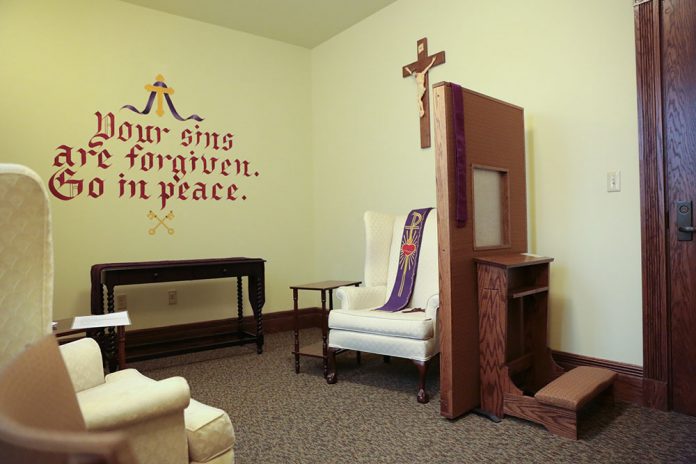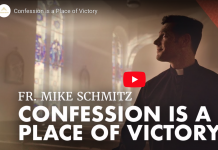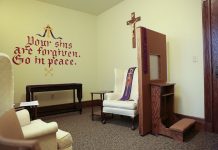
by Kate Ristow
[CLICK HERE] for a worksheet that can help students recall what they learned about God’s grace.
The theme of CATECHIST’s January issue each year is the liturgical life of the Church and the Sacraments—what they mean to us as Catholics and the different ways we can teach about them in our classes. The United States Catholic Catechism for Adults emphasizes that that the Sacraments have a visible and invisible reality (see page 168).
At Mass and in the celebration of every Sacrament, there are things we can grasp through our senses—things we can hear, see, touch, smell, and taste. The words of absolution in Reconciliation, the water poured at Baptism, the joining of hands at Matrimony, the incensing at the Easter Vigil or a funeral Mass, and the reception of the consecrated bread and wine in the Eucharist: These all are visible signs of God’s presence with us. We call God’s life-giving presence grace.
In order for children to fully understand what the Sacraments mean in our lives, it is important for them to know what grace is. Grace is “favor, the free and undeserved help that God gives us to respond to his call to become children of God, adoptive sons, partakers of the divine nature and of eternal life” (Catechism of the Catholic Church, n. 1996, emphasis in original). When we say that grace is a “favor,” we mean that it is a gift from God, a gift we cannot earn on our own. Grace is the gift of God’s life within us and the help God gives us to live as his children.
Original Holiness
God created everything out of goodness and love. He made us in his image and likeness (Genesis 1:26). In the New Testament we read, “Be holy because I (am) holy” (1 Peter 1:16). God calls each of us to holiness, to be like him, and to live in communion and relationship with the Holy Trinity. Grace makes it possible for us to become holy.
ACTIVITY: Have students brainstorm things that holy people do. List responses on the board. Possible answers may include things like “share their time and possessions,” “treat others with love,” “care for people in need.”
ACTIVITY: Have students describe traits or qualities of a holy person (prayerful, kind, loving, forgiving, etc.). List responses on the board and discuss with students how a person becomes holy. Lead the class to the conclusion that we become holy by following the teachings of Jesus, receiving the Sacraments, and being helped by God’s gift of grace.
ACTIVITY: Have students work in small groups to come up with the name of a person they think of as a holy person and the reasons why they consider that person holy. Invite a volunteer from each group to share his or her group’s responses with the class.
Sanctifying Grace
Sanctifying grace is the gift of God’s life and love. We are made holy be sanctifying grace. Sanctifying grace makes it possible for us to share in the divine life of the Holy Trinity.
The word sanctify means “to make holy.” We first receive the gift of sanctifying grace at Baptism. Remind students that Original Sin is washed away when we are baptized; we are returned to the original holiness God intends for all his children. We are born again and receive new life in Jesus as children of God. We also receive the gift of the Holy Spirit, who helps us live holy lives. These are some of the graces we receive at Baptism.
ACTIVITY: Have students return to their small groups, and give each group a piece of paper. Have students fold the paper in half vertically, making two columns. Label the left column “Sacraments” and the right column “Graces of the Sacraments.” Have students list the names of the Seven Sacraments in the left column and list the effects of the graces we receive in each Sacrament in the right column. For example, when we celebrate the Sacrament of Penance and Reconciliation, we are reconciled with God and the Church community. Our sins are forgiven, and we receive the grace to begin again to live as God’s children and disciples of Jesus. Allow students to use their texts for this activity. It will help them recall the different aspects of each sacramental rite.
ACTIVITY: Using the sign illustrations provided in Signing Prayer [CLICK HERE], teach students to sign a simple prayer and definition for grace: “Grace is God’s gift to us. Alleluia!” Explain to the students that they will learn to sign only the main words (grace, God, gift, and alleluia) but they will pray the entire definition as they sign it.
ACTIVITY: Take students to your parish church and show them the oils used in the celebration of the Sacraments: sacred chrism, used in Baptism, Confirmation, and Holy Orders; Oil of the Catechumens, also used in Baptism; and the Oil of the Sick, used in the Sacrament of the Anointing of the Sick. Show the children the ambry where the oils are kept and explain how the oils are distributed in your diocese. Point out that your bishop blesses them at the Chrism Mass, attended by a priest or representatives from each parish during Holy Week.
Help the children make the connection between the gift of faith and the gift of grace. Like grace, faith is not something we can earn; we cannot have faith without the help of the Holy Spirit. Read together the following Act of Faith. Encourage students to learn this prayer by heart and to pray it often. Emphasize that they can also use their own words to ask the Holy Spirit to help them grow in faith.
Act of Faith
O my God, I firmly believe that you are one God in three Divine Persons, Father, Son, and Holy Spirit. I believe that your Divine Son became man and died for our sins and that he will come to judge the living and the dead. I believe these and all the truths which the Catholic Church teaches because you have revealed them, who are eternal truth and wisdom, who can neither deceive nor be deceived. In this faith I intend to live and die.
Amen.
Actual Grace
In addition to the sacramental graces that sanctify us, God gives us additional help in living as his children through the gift of actual grace. When we cooperate with the Holy Spirit’s presence in our lives, the Spirit guides our conscience and helps us to make good choices.
We receive actual grace through prayer and asking Jesus’ help in living as his disciples. Reading the Bible or stories of the lives of the saints are other ways we can respond to God’s gift of grace. Explain that, with the gift of actual grace, God helps us to choose good and avoid sin.
ACTIVITY: Have students form teams of two or three and invite each team to write out a moral dilemma that involves a young person their age facing a temptation. Encourage each team to make its dilemma realistic, involving a situation that reflects a challenging issue young people encounter today. Then invite each group to share its dilemma with the class, either by reading it or acting it out. Have students discuss what they might do in a similar situation. Remind them that they can always turn to the Holy Spirit in prayer when faced with a difficult decision.
ACTIVITY: Invite students to use the internet or books about the saints to find saints they admire and feel that they could turn to for help in living their Catholic faith. As an alternative, you may want to tell students pertinent details from the lives of a few of your favorite saints or blesseds who have inspired you and to whom you pray. For example, you might suggest John Vianney, Thérèse of Lisieux, Peter To Rot, Pierre Toussaint, Catherine McAuley, and Carlos Manuel. Be sure to tell the story, even if it is only one detail, rather than reading it from a book. This better humanizes the holy person.
ACTIVITY: Remind students that God loves us so much that he gives us the wonderful gifts of sanctifying grace and actual grace to help us live forever in his heavenly kingdom. In the hymn “Amazing Grace,” we sing, “’Tis grace has brought me safe thus far, and grace will lead me home.” Perhaps an image that students might identify with is that of a GPS (global positioning system). Invite them to think of grace as God’s GPS. If we participate in and are receptive to the Sacraments, especially the Eucharist, and if we cooperate with the many helps the Holy Spirit gives us, God’s grace will, as the hymn promises, “lead us home.”
Kate Ristow, Contributing Editor to CATECHIST, has worked in Catholic publishing for over 25 years as a national speaker and writer, building on a wealth of experience in the religious formation of children and catechists in both parish and Catholic school programs.
The new CSS cleaner allows you to organize your style sheets.
Copyright 2013, Bayard, Inc. All rights reserved. This article is protected by United States copyright and other intellectual property laws and may not be reproduced, rewritten, distributed, redisseminated, transmitted, displayed, published or broadcast, directly or indirectly, in any medium without the prior written permission of Bayard, Inc.




